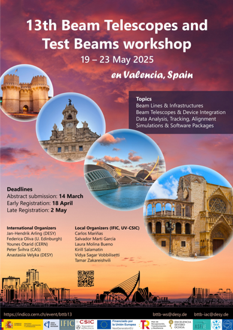Speaker
Description
The High-Luminosity upgrade of the Large Hadron Collider (HL-LHC) at CERN will require silicon pixel detectors that can withstand extreme radiation levels. To face these challenges, the ATLAS experiment will carry out its Phase II Upgrade. This includes replacing the current tracking system with the all-silicon Inner Tracker (ITk), whose innermost layer will feature radiation-hard 3D sensors. These 3D sensors must tolerate fluences over 1E16 neq/cm2 over their lifetime operation in ATLAS. In this talk, we present test beam results for a pre-production 3D pixel sensor developed by SINTEF using a single-sided fabrication process. The sensor was irradiated to a fluence of 1.7E16 neq/cm2 and measured using the EUTelescope setup at the CERN test beam facility. The analysis delivered an excellent outcome, with a hit detection efficiency of up to 98% at perpendicular beam incidence after irradiation.
